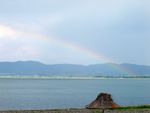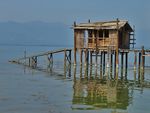
- Geographical location;
Dojran Lake is a lake with an area of 43.1 km² shared between the Republic of Macedonia (27.3 km²) and the Republic of Greece (15.8 km²). To the west is the city of Dojran, to the east the village of Mouries and to the north the mountain Belasica. The lake has a rounded shape, a maximum depth of 10 m and a north-to-south length of 8.9 km and is 7.1 km at its widest, making it the third largest lake partially in the country after Lake Ohrid and Lake Prespa.
- An old folklore legend;
According to an old legend, a Macedonian girl named Dojrana was accustomed to fetching water from special springs that had to be sealed following use. Yet at the very moment Dojrana was filling her jugs, she heard that her beloved had come back from the army, and forgot to seal the springs. Lake Dojran was, the legend says, the result of her unthinking euphoria.Due to the Mediterranean climate of southern Macedonia and the proximity of the balmy Aegean not far to the south, vegetation starts blooming in the Dojran area in early spring and continues to do so until late autumn.
 Panaromic view of the lake;
Panaromic view of the lake;
- The ecosystem;
And so though Lake Dojran is only 10 meters (30 feet) deep at its deepest point, it is brimming with life. Owing to the large quantity of weeds that grow in the lake and the large number of plankton on its surface, Dojran’s waters are considered to be very beneficial for treating rheumatism, skin diseases and respiratory diseases, and many tourists come for precisely this reason.
Characteristic
of the lake are the fishing boats and the fishermen’s huts standing on
stilts above the surface of the water.
 The unique fishermen's huts;
The unique fishermen's huts;
The method of fishing here is very original and very old, performed with the help of the cormorants, gulls and other birds that fly above the lake, directing the fish into the baskets where they are gathered in huge quantities.
- Historical monuments and nearbay settlements;
The Amam is a Turkish bath located in the upper part of the city and in the past it was inhabited by the Turkish population. The year it was built is unknown and only parts of the tower remain. The Church of St. Ilija was built in 1874 in the northern part of the city. The current state of the church; fragments of paintings, suggests that the church walls were originally covered with frescos. Dojran is also significant archeologically due to numerous discoveries of accidental or systematic excavations including relief, marble plates with greek inscriptions, remainders of walls, coinstoumbs with epitaphs.
The
father of history himself, Herodotus, noted Dojran’s great richness in
fish way back in the 5th century B.C.E. According to him, the lake was
so teeming with fish that if you put an empty basket in the water at
night, by morning it would be full. These days, the best known types of
fish are red-finned carp, trout, perch, sheatfish, eel and claw-fish. Near the lake are two small towns Star( Old ) and Nov ( New ) Dojran( the bouth are known under the common name Dojran ), in bouth towns are located hotels and private apartments witch offers superb service and accommodation for the tourists.